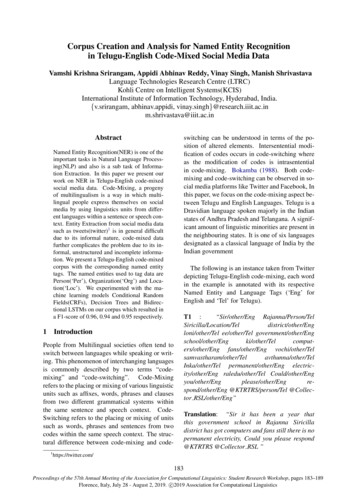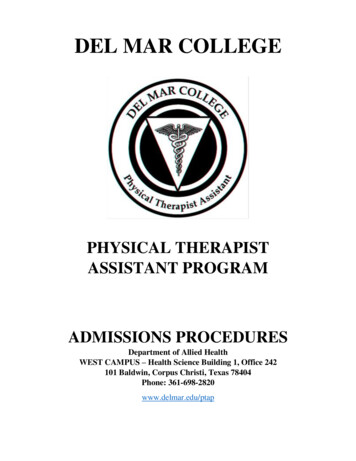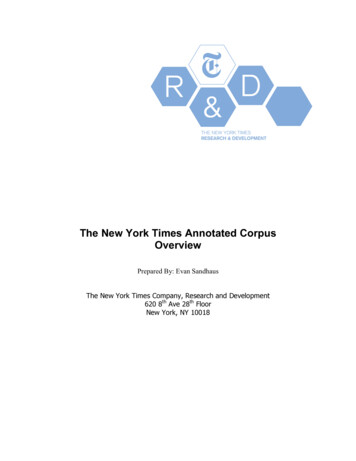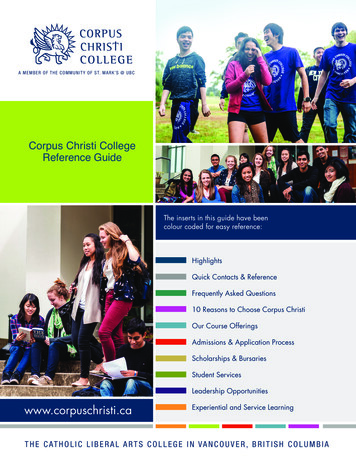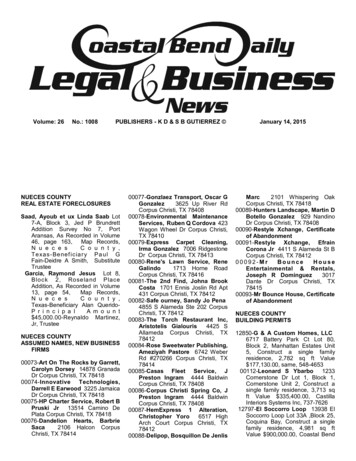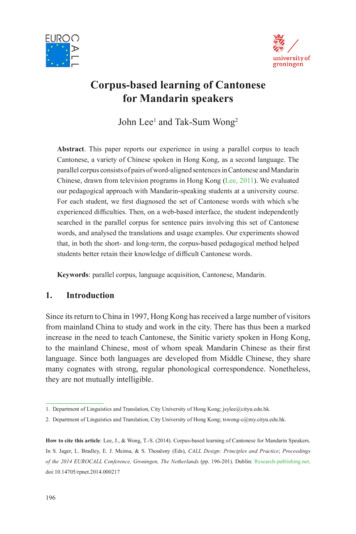
Transcription
Corpus-based learning of Cantonesefor Mandarin speakersJohn Lee1 and Tak-Sum Wong2Abstract. This paper reports our experience in using a parallel corpus to teachCantonese, a variety of Chinese spoken in Hong Kong, as a second language. Theparallel corpus consists of pairs of word-aligned sentences in Cantonese and MandarinChinese, drawn from television programs in Hong Kong (Lee, 2011). We evaluatedour pedagogical approach with Mandarin-speaking students at a university course.For each student, we first diagnosed the set of Cantonese words with which s/heexperienced difficulties. Then, on a web-based interface, the student independentlysearched in the parallel corpus for sentence pairs involving this set of Cantonesewords, and analysed the translations and usage examples. Our experiments showedthat, in both the short- and long-term, the corpus-based pedagogical method helpedstudents better retain their knowledge of difficult Cantonese words.Keywords: parallel corpus, language acquisition, Cantonese, Mandarin.1.IntroductionSince its return to China in 1997, Hong Kong has received a large number of visitorsfrom mainland China to study and work in the city. There has thus been a markedincrease in the need to teach Cantonese, the Sinitic variety spoken in Hong Kong,to the mainland Chinese, most of whom speak Mandarin Chinese as their firstlanguage. Since both languages are developed from Middle Chinese, they sharemany cognates with strong, regular phonological correspondence. Nonetheless,they are not mutually intelligible.1. Department of Linguistics and Translation, City University of Hong Kong; jsylee@cityu.edu.hk.2. Department of Linguistics and Translation, City University of Hong Kong; tswong-c@my.cityu.edu.hk.How to cite this article: Lee, J., & Wong, T.-S. (2014). Corpus-based learning of Cantonese for Mandarin Speakers.In S. Jager, L. Bradley, E. J. Meima, & S. Thouësny (Eds), CALL Design: Principles and Practice; Proceedingsof the 2014 EUROCALL Conference, Groningen, The Netherlands (pp. 196-201). Dublin: 0217196
Corpus-based learning of Cantonese for Mandarin speakersSpoken by more than 55 million people, Cantonese is the “most widely known andinfluential variety of Chinese other than Mandarin” (Matthews & Yip, 2011, p. 3).Because Cantonese is a predominantly spoken language, it is relatively difficult forlearners to find written samples of the language. Example sentences in textbooksare often artificially created, and do not always reflect the most colloquial or currentusage. In this paper, we explore the use of a parallel corpus of Cantonese andMandarin Chinese (Lee, 2011) as bilingual teaching material. The corpus containsmore than 8000 Cantonese-Mandarin sentence pairs; the Cantonese sentences aretranscriptions of television programmes, while the Mandarin sentences are thecorresponding subtitles. In addition, the Cantonese and Mandarin words in eachsentence pair are aligned. An example is shown in Table 1.While computer-assisted language learning (CALL) for Mandarin has been muchinvestigated (e.g. Shei & Hsieh, 2012; Yang & Xie, 2013), less attention has beenpaid to acquisition of Cantonese as a second language. Most previous studies havefocused on pronunciation (Ki, 2006; Shī, 2002; Wong, 2010; among others), whileresearch in vocabulary acquisition has been limited to contrastive studies of thecorrespondence between these two languages (e.g. Zeng, 1991). This paper is thefirst to evaluate the use of parallel corpus for teaching Cantonese to Mandarinspeakers. In a classroom experiment, we show that our corpus-based pedagogicalmethod significantly improved the students’ Cantonese proficiency.Table 1. Examples of word-aligned Cantonese-Mandarin sentence pairs fromthe parallel corpus used in our study (Lee, 2011)The Mandarin le has different Cantonese counterparts in different contexts. As aperfect aspect particle, its Cantonese equivalent is jó (top sentence); as a moodparticle, however, its Cantonese equivalent is la (bottom sentence, Table 1).One can for example search sentences using Cantonese or Mandarin keywords, andview word alignments between Cantonese-Mandarin sentence pairs (Lee, Hui, &Yeung, 2013)197
John Lee and Tak-Sum Wong2.Experiment2.1.Research questionBeyond the textbook, language teachers often want to employ authentic examplesfrom contemporary media as pedagogical material in the classroom. BecauseCantonese is a predominantly spoken language, it can be difficult to find suchexamples for Cantonese in the written form. In this study, we explore the use ofa recently compiled parallel corpus of Cantonese and Mandarin Chinese (Lee,2011) for this purpose. We have developed a web interface (Figure 1) to facilitateindependent learning of Cantonese by Mandarin-speaking students. Students canretrieve sentences containing particular Mandarin or Cantonese keywords, viewthe Mandarin-Cantonese sentence pairs, and study the word alignments (Lee et al.,2013). In this paper, we investigate the extent to which this corpus-based methodenhances the teaching of Cantonese as a second language.Figure 1. The web interface used in the CALL session in our study2.2.Experiment designThe evaluation took place at a 13-week course, Cantonese Communication Skills forPutonghua Speakers, offered at City University of Hong Kong. In total, 34 students198
Corpus-based learning of Cantonese for Mandarin speakersparticipated, of which 27 completed all four tasks. All were Mandarin-speakingundergraduate students. Before taking this course, most had little knowledge ofCantonese.During the 7th week, we administered a pre-test, which contained 24 Mandarinsentences, each with one word underlined. The students were asked to translatethe underlined word into Cantonese. We chose Mandarin words (e.g. the word lein Table 1) that had at least two different translations in Cantonese (jó and la),depending on context. Specifically, the test assessed each student on 12 Mandarinwords, each appearing in two sentences requiring two different Cantonesetranslations. Overall, for 47.8% of these words, the students gave incorrectCantonese translations in at least one of the two contexts; we collected these wordsto be used in our CALL experiment.Two weeks later, each student completed a CALL session, using the web interfaceof the parallel corpus shown in Figure 1. Given a list of Mandarin words, thestudent was asked to search for sentences in which they appear, retrieve the originaltranscribed Cantonese utterance, and analyse the meanings and functions of theCantonese words to which they were aligned. We personalised the list for eachstudent, by randomly selecting half of the Mandarin words which the student failedto translate correctly in the pre-test (henceforth, the “CALL set”), and excludingthe other half as control (the “non-CALL set”).Immediately after this session, we administered a post-test to measure the shortterm effect of the session. As in the pre-test, the student was asked to translate thesame 24 Mandarin words, although in different sentences and contexts. After threeweeks, we administered a delayed post-test, using the same Mandarin words butagain in different contexts, to measure the long-term effect.2.3.Experimental resultsA summary of our experimental results is given in Table 2. To ensure there is nosignificant difference in the students’ previous knowledge about the words in theCALL and non-CALL sets, we first compare their performance on these two sets inthe pre-test. The students correctly translated 38.0% of the words in the CALL set,and 36.8% in the non-CALL set. The difference in their performance on the twosets is not significant3.3. By chi-square test, χ² 0.36, p 0.05, d.f. 1199
John Lee and Tak-Sum WongIn the post-test, after the CALL session, student performance on both sets improvedsubstantially. Even for words in the non-CALL set, which were not involved in theCALL session, the score rose to 69.4%. The students likely noticed some of thesewords in the sentences they browsed, and learned about their usage as a side effect.Meanwhile, the score on the CALL set increased even more sharply, to 86.7%.Hence, even with the beneficial side effect, student performance on the CALL setwas significantly higher4 than on the non-CALL set. These figures suggest that thecorpus-based pedagogical approach was very effective in the short-term.In the delayed post-test, as expected, student performance on the CALL setdecreased slightly to 83.7%, while the non-CALL set increased to 74.3%. However,the score on the CALL set remained significantly better5 than that of the non-CALLset. These results suggest that the use of the parallel corpus also improved students’Cantonese proficiency in the long-term.Table 2. Average student score for Mandarin-to-Cantonese translation, dividedinto the CALL set (those words that are studied in the CALL session)and the non-CALL set (the rest)Scores on the former set were significantly higher than on the latter set in the posttest and delayed post-test. In all three tests, there were 166 words in the CALL setand 144 in the non-CALL set.3.Conclusions and future workWe have investigated the effect of a corpus-based pedagogical method forteaching Cantonese as a second language. This method centers on a personalisedcomputer-assisted language learning session, where each student activelysearched in a parallel corpus (Lee, 2011) and learned about usage of Cantonesewords for which s/he previously failed to master. Compared to the pre-test, thestudents demonstrated significantly higher proficiency in Cantonese in the posttest; the long-term effect, as measured in the delayed post-test, is also strong.4. By chi-square test, χ² 0.99, p 0.0005, d.f. 15. By chi-square test, χ² 0.84, p 0.05, d.f. 1200
Corpus-based learning of Cantonese for Mandarin speakersFor future work, we would like to enrich the corpus by providing pronunciationinformation, and to use the interface to teach Cantonese grammar.ReferencesKi, W. W. (2006). Computer-assisted perceptual learning of Cantonese tones. Paper presented atthe 14th International Conference on Computers in Education, Peking, Nov 30-Dec 4.Lee, J. (2011). Toward a parallel corpus of spoken Cantonese and written Chinese. In Proceedingsof the 5th International Joint Conference on Natural Language Processing (pp. 1462-1466),Chiang Mai, Thailand, November 8 13, 2011.Lee, J., Hui, Y. C., & Yeung, C. Y. (2013). Toward a digital library with search and visualizationtools. In Proceedings of the 6th Language and Technology Conference.Matthews, S., & Yip, V. (2011). Cantonese: A comprehensive grammar (2nd ed.). London:Routledge.Shei, C., & Hsieh, H.-P. (2012). Linkit: A CALL system for learning Chinese characters, words,and phrases. Computer Assisted Language Learning, 25(4), 319-338. doi:10.1080/09588221.2011.589390Shī, Z. (2002). Guǎngzhōu yīn Běijīng yīn duìyìng shǒucè 廣州音北京音對應手冊 [A handbookon the correspondence between Cantonese pronunciation and Pekinese pronunciation].Canton: Jinan University Press.Wong, T.-S. (2010). A pilot study on the outcome of teaching phonological correspondencein Cantonese class for Mandarin speakers. Paper presented at the 2010 Annual ResearchForum of the Linguistic Society of Hong Kong (LSHK-ARF 2010), Hong Kong. Retrievedfrom http://www.lshk.org/arf2010/doc/LSHK-ARF 2010 abstracts 2.0.pdfYang, C., & Xie, Y. (2013). Learning Chinese idioms through iPads. Language, Learning &Technology, 17(2), 12-23.Zeng, Z. (1991). Colloquial Cantonese and Putonghua equivalents (3rd ed.) (S. K. Lai, Trans.).Hong Kong: Joint Publishing (Hong Kong) Company Limited.201
Cantonese, a variety of Chinese spoken in Hong Kong, as a second language. The . Beyond the textbook, language teachers often want to employ authentic examples from contemporary media as pedagogical material in the classroom. Because Cantonese is a predominan

